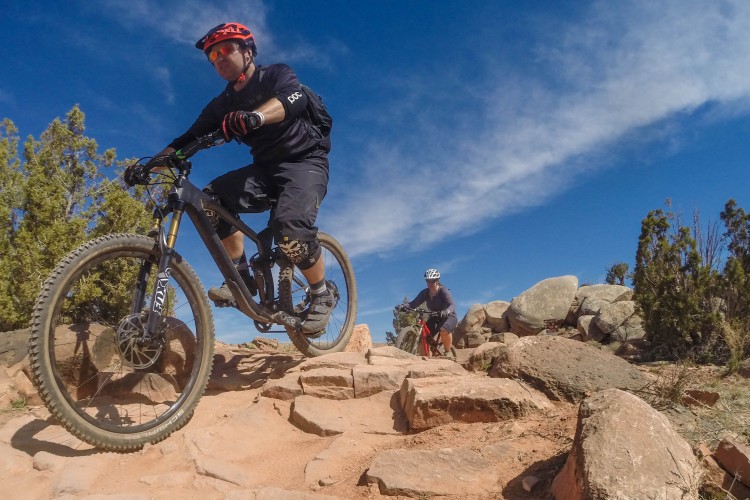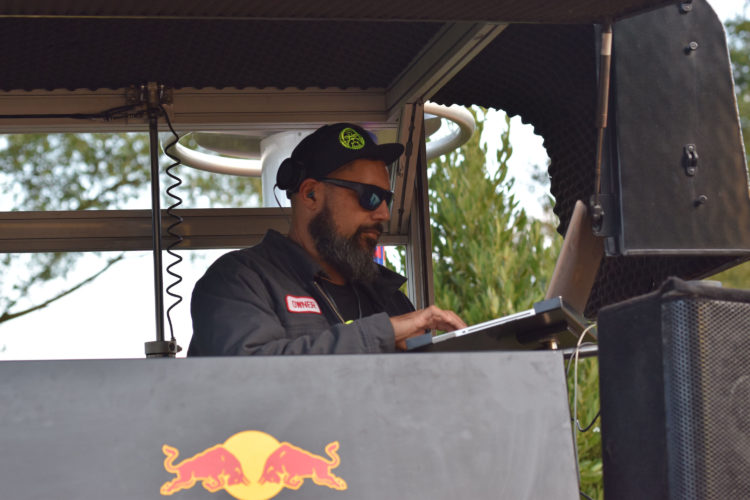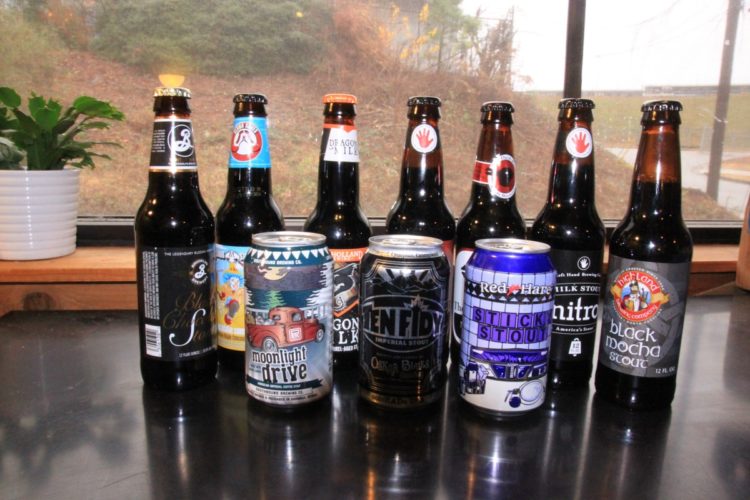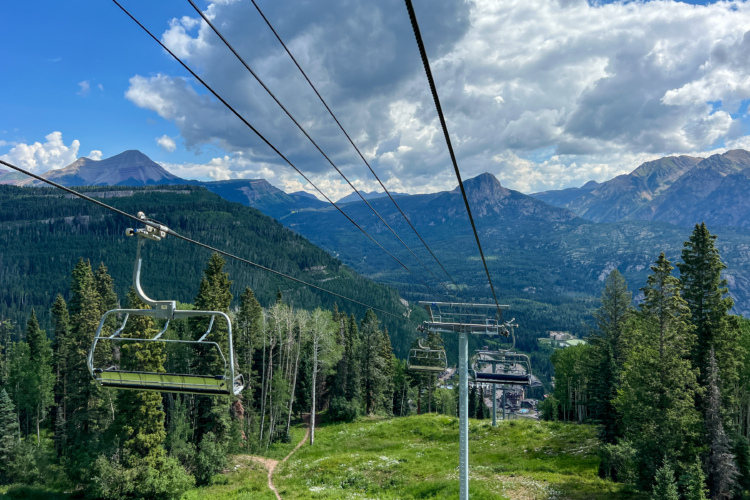
I’ve been mountain biking for decades, and as far back as I can remember, mountain bikers have always taken pride in how much more difficult MTB is compared to road riding. I’ve heard rules of thumb like multiplying the length of a mountain bike ride by two or three to get the equivalent road ride, and based on my own experience, I’d say something close to the two-times rule seems about right. But how much more difficult is mountain biking, really? I decided to see if science could get me closer to an answer to that question.
I’ve been testing a fancy power meter from PowerTap, and I used it to set up a controlled test to isolate the factors that make mountain biking more difficult than road biking. These are the three main factors I considered:
- Obstacles on the trail. The number and size of trail obstacles can vary wildly, and generally come in the form of rocks and roots. Paved roads, by comparison, are generally smooth and obstacle-free. Trail obstacles slow riders down and increase the amount of physical effort required.
- The trail surface itself. Dirt and vegetation slow riders down compared to solid, high-traction pavement.
- Tire resistance and aerodynamics. Fat, squishy tires add resistance over skinny, high pressure road tires. Road bikes place riders into a more aero position and generally cut a narrower overall profile as well.
Factors I decided not to consider because they are not unique to road or MTB riding:
- Mountain bike trails often have sharp, steep climbs, while roads usually stick to milder, more consistent grades. However, roads can have steep grades and quick reversals, just like mountain bike trails can be flat. If we’re truly looking at what makes MTB harder than road riding, we have to normalize for elevation gains and losses. A road ride in the mountains is certainly more difficult than a MTB ride on a railroad-grade trail. For my test, I kept the surface grade the same.
- Road bikes are generally lighter than mountain bikes but every bike (and every rider) is different. Plus it’s pretty obvious that pedaling a lightweight bike will be easier than pedaling a heavy one, and this isn’t unique to road biking. One could make mountain biking easier by dropping a few pounds off the bike and/or rider, too. For my test I kept the overall weights of the test bikes the same, adding weights to the road bike to normalize weight between the two bikes.
- Trails typically have more twists and turns than roads, and believe me, cornering definitely takes an energy toll during a ride! But a lack of turns isn’t unique to riding a road bike just like twists and turns aren’t unique to mountain biking. Some MTB trails can run straight as an arrow for long sections while riding a greenway path on a road bike can involve a significant amount of turning.
- Stop-and-go riding due to traffic signals can take a real toll on road rides, just like dismounting for hike-a-bike can for MTB rides. Roads and trails can vary wildly from this perspective, so comparing the two might just be a matter of counting the number of times the rider has to accelerate from a stop or near stop. Some road rides might have a lot of acceleration points while a MTB ride on a flow trail could have relatively few.
- Suspension, even when properly tuned, sucks energy during a ride. I want to test this separately but for now, I stuck with a hardtail with the front suspension locked out. Not all mountain bikes have suspension, anyway.
- Decision making–that is, choosing lines–is mentally taxing which can, in turn, exact a physical toll. Really technical trails require more frequent decisions but then again, riding in traffic can be equally stressing. For that reason, I decided not to test this factor.
Testing the effort to clear obstacles

I set up a 0.10-mile test track right outside the Singletracks office, which happens to be on a hill with a decent grade. For the control test, I pedaled up the concrete path on my mountain bike three times at the same speed each time, and measured the overall power I expended.
Next, I set up ten obstacles along the same path at even intervals: 6 two-by-four and 4 four-by-four pieces of lumber. I figure the two-by-fours, at 1.5 inches tall, roughly simulate trail roots, while the four-by-fours, at 3.5 inches tall, are more like the rocks one might find on a trail. I pedaled this course three times again, keeping the same speed as I did in the control test.
The result: the obstacles required a 9% increase in power to keep the same pace as in the control test. Now, if the obstacles had been larger or spaced more closely together like a rock garden, that number would obviously rise. Now I understand why it’s impossible to form an exact comparison between the difficulty of road and mountain bike riding! Every trail is different.
Testing a natural surface

Admittedly my test track for this one wasn’t perfect. I really wanted to test hardpack, but it was important to keep the exact same grade as in my pavement test. Instead, I ended up testing in patchy grass and leaves. Sure, this isn’t ideal but then again, few trails have consistent surfaces along their length anyway. Riders can encounter pretty much anything on the trail including sand, rocks, packed dirt, mud, weeds, grass, and fallen leaves.
Surprisingly, I found the patchy grass and leaf surface required nearly 31% more power than in my control test! Personally I’ve always hated riding on grass and I’ve long suspected that it was more difficult to ride on grass than other trail surfaces. But still, 31% is a big jump. I suspect hardpack or even loose-over-hard would add far less than 31% to the effort required.
It might be interesting to set up a separate test on trail surfaces alone to understand how much difficulty each one adds. But even within surface types we’re sure to find variations. For example, “sugar sand” seems to add more resistance than, say, course river sand. And muddy clay will slow tires way more than organic black dirt.
Testing tires plus aerodynamics
The PowerTap hub I’m testing is built into an MTB wheel, so I didn’t have a way to mount it to my road bike. However, from my tire pressure tests a while back, I learned that downhill speeds are a pretty good proxy for uphill climbing power changes, at least for the purposes of this test. I added 8.5 pounds to my setup to even up the weight between the road and mountain bikes I used in the test. For those who are interested, the mountain bike was a 29er running 2.3″ MTB tires at about 30psi. The road bike was running standard road bike tires at about 80psi.
Based on the speed test, I found the road bike rolled, on average, about 11% faster than the mountain bike. One interesting thing to note is that a lot of the speed difference in the test seemed to come in the first 10 yards along the test track as the bikes accelerated up to speed. The increased rolling mass of an MTB tire compared to a road wheel makes a big difference here.
Bottom Line
Based on the factors I was able to test, I found a 51% increase in the effort needed to ride a mountain bike on a grassy, leafy trail with obstacles, compared to a road bike on a paved surface. Remember, that assumes a mountain bike course with grades and turns that are similar to what one would ride on the road. It also assumes riding a mountain bike without suspension. For bikes with suspension, there will be additional energy expended on the trail.
Adding in all the additional factors I mentioned above, it’s easy to see how the percentage increase in effort could get to 100% or beyond, which would match up with the 2-times estimate I mentioned at the beginning. I don’t know what the upper limit might be (if there even is one), but if I were pressed, I would say mountain biking requires 50-150% more effort than a road ride of equivalent distance. So, I would say a 10-mile mountain bike ride is roughly the same (physically) as a 15-25 mile road ride.
Of course, another quick way to estimate is to look at average speeds. If a rider averages 8mph on an MTB ride and 18mph on a road ride, that means the equivalent road ride is about 125% longer than the MTB ride, assuming the same total moving time and average heart rate for both rides. This fits nicely within the range I estimated based on my tests.
Your turn: What did I miss? What is the factor you use to estimate the road ride equivalent of your MTB rides?











20 Comments
Jul 15, 2018
Dec 30, 2018
Jul 19, 2016
Jul 24, 2016
Jul 24, 2016
One thing to consider is that if you an advanced trail rider, throwing the bike around also requires more physical effort. But as before stated, when you're having a great time doing something you love, those things aren't even noticed as effort, just relaxing, therapeutic, smiles.
High five on the science to put values to what we know, nice to see some numbers! Take care.
-GT
Jul 23, 2016
Aug 5, 2018
Jul 19, 2016
Jul 20, 2016
Nov 5, 2018
I understand the difficulty with comparing the other areas, and thus leaving them out of this test, except to land on a general 50% - 150% increase vs road biking. Some of the other areas mentioned though do bear a big significance.
For example, bike weight. Yes, some Mtn bikes are lighter than some Rd bikes, but as stated, Rd bikes are generally lighter. Consider the equivalent bike: similar level of components, cost and quality, ect… the MTB is heaver.
Also, the sharp steep climbs and twists and turns…sure the roads can have those too, but not like on the trail, in general. This can be deduced by the fact that Mtn bikes usually have lower gearing. Roads are designed for cars. When’s the last time you were going up a hill on a road so steep, you were struggling to keep traction on your rear tire while hopping it over rock and root obstacles in loose dirt, and you were turning so sharp on that switchback, that you found one of your handlebars between your knees, struggling to keep your balance going around that big rock sticking out into the trail? I do that almost every MTB ride at least once or twice, …but I can’t think of a single time I’ve had to do that on the road.
Starting and Stopping…You have red light breaks on the road. Your stopped. You are going nowhere, and are recovering. On an MTB, I generally like to keep moving. I’ll stop once in a while to see where I am, or take in the view, but it’s not usually as often as I’m hitting red lights on the road. This does depend on where you’re riding though, in both road and mountain locations.
The suspension is another thing too, and I appreciate you would consider that separately.
As GTXC4 said, being on the road is mentally taxing too, navigating all the 2 ton obstacles that are always trying to hit you, claiming they don’t see you. It’s just a different kind of thinking required for Rd vs MTB.
Again, thanks for the great article!
Jul 15, 2018
What I have found from roadie versus MTB is that my fitness level improved. That’s from a baseline coming from trackers. Probably not completely accurate or scientific but based on my fitness tracker, heart rate went down, active minutes went up and calories burned went way up.
Jul 22, 2016
Jul 24, 2016
Jul 21, 2016
For more science type stuff on MTB follow: P.W.Macdermid and Co on www.researchgate.net
Jul 21, 2016
Jul 21, 2016
Jul 21, 2016
but for me subjectively the more variable power put in when mountainbiking suits my body better than the more continuous effort when roadbiking. air resistance is a formidable enemy.
Jul 21, 2016
As for not being able to cope with the constant effort of Rd i fully agree. Ask a marathon runner to play a game of soccer. It will kill their legs pretty quickly!
Jul 24, 2016
Jul 23, 2016
as a BMXer & MTBer i almost never sit...